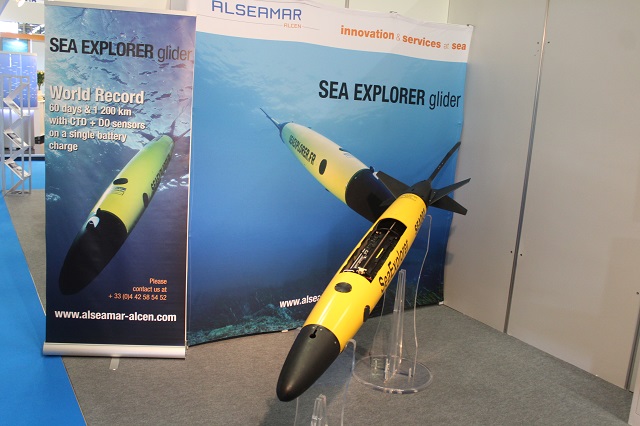 The
Sea Explorer vehicle moves through the water by varying its buoyancy,
resulting in very long endurance and stealthy actuation. It resurfaces
regularly to transmit information back to the operator including its positioning,
on the ongoing mission, etc… Pictures: Alseamar The
Sea Explorer vehicle moves through the water by varying its buoyancy,
resulting in very long endurance and stealthy actuation. It resurfaces
regularly to transmit information back to the operator including its positioning,
on the ongoing mission, etc… Pictures: Alseamar |
|||
The two
Deep Explorer gliders to be developed will be built on the European underwater
glider Sea Explorer. The Sea Explorer was designed in the frame of a 6-years
cooperative R&D programme labelled by the French Marine business and
innovation Pôle Mer Méditerranée cluster. The Sea
Explorer consortium was composed by the Alseamar company (ex-ACSA) as
system architect and the ACRI company as well as public laboratories such
as MIO (Mediterranean Institute of Oceanography), the IFREMER (Institut
Français de Recherche pour l’Exploitation de la Mer) and
the LOV (Laboratoire d’Océanographie de Villefranche-sur-mer).
In line with the Sea Explorer programme, the French Pôle Mer Méditerranée
cluster has strongly supported the BRIDGES project since the beginning
and has officially labelled it BRIDGES. During BRIDGES, it is planned that the sole European underwater glider Sea Explorer will be modularised and adapted to more diverse operations, able to dive deeper and to carry new sensors that will be developed, while the operational methodology will be modified in such a way that new horizons of services could be opened. The Sea Explorer glider, a rocket-shaped vehicle, typically navigates autonomously in the ocean for months at a low speed (~30km/day) to collect a variety of data and report back to the land station. New Explorer gliders will be improved by: 1) adapting for deep basins (up to 5,000m), 2) implementing a novel payload architecture to increase autonomy and to accommodate the range of sensing capabilities needed, and 3) integrating the associated control support system for single and networked operations (mission behaviour, data management, planning, communications). |
|||
 Alseamar
stand at UDT 2015 Alseamar
stand at UDT 2015 |
|||
The scientific
coordinators of BRIDGES are Dr Laurent Mortier from the Ecole Nationale
Supérieure de Techniques Avancées (ENSTA-ParisTech) which
is part of Armines and Dr Pierre Testor from UPMC. BRIDGES is managed
by Armines, a contract research association and partner of the major French
Engineering Schools that manages the Horizon 2020 project. The project
started in April 2015 and will last 48 months. The consortium is composed
of 19 public and private partners from 7 EU countries (SP, PT, UK, FR,
NL, D, CY) and 2 associated countries (NO, IS) including: Université
Pierre-et-Marie Curie (UPMC), Alseamar, Hydroptics, Natural Environment
Research Council (NERC), University of Southampton, BMT Isis Limited,
University of Cyprus, Cyprus Subsea Consulting and Services Limited (CSCS),
OceanScan – Marine Systems & Technology Lda (MST), Universidade
Do Porto, Albatros Marine Technologies S.L., ENITECH GmbH, 52°North
Initiative for Geospatial Open Source Software GmbH, Christian Michelsen
Research AS (CMR), International Research Institute of Stavanger AS (IRIS),
the Hebrew University of Jerusalem (HUJI), Ecorys Nederland BV and the
Society for Underwater Technology (SUT). The Alseamar company has been granted 2M Euro and will play a leading role acting as the leader of the Work Package dedicated to developing a family of two vehicles: one deep glider capable of diving down to 2,400m at a low cost with high TRL levels, and one ultra-deep 5,000m glider version of higher cost and lower TRL levels. The NERC is another major partner. NERC will lead the enhancement of the glider’s sensing capacities. The main planned sensing modules are for: 1) environmental monitoring for facilitating the effective implementation of an ecosystem-based management under the Marine Strategy Framework Directive, 2) the oil and gas industry, and 3) the deep sea mining industry. At the end of the project, it is expected that Alseamar will offer the largest range of underwater gliders on the market with qualified sensors packages to fulfil coastal and deep waters users’ needs: Sea Explorer glider (rated 700m), Deep Explorer (2,400m) and Ultra-Deep Explorer (5,000m). In order to achieve the scientific and technological objectives and meet service requirements, an open dialogue between stakeholders will be developed. In addition, the project will promote the creation of collaborations among miniaturised sensor and underwater platform manufacturers, oil and gas and mining companies, public research entities, and scientific and engineering experts. Pierre Bahurel, general manager of the French ocean forecasting centre Mercator Ocean and also leader of the recently established Copernicus Marine Service, observed that ”the glider technology has proven to be one of most promising observing techniques to complement other classical in-situ observing systems, such as Argo profilers and moored arrays”. And added: ”A series of deep gliders has a strong role to play in operational oceanography and our knowledge of the oceans.” |
|||
ALSEAMAR Sea Explorer High Performance Underwater Glider at UDT 2015
- Posted On





 Alseamar'
Sea Explorer underwater glider at UDT 2015
Alseamar'
Sea Explorer underwater glider at UDT 2015




